Dreadlocks have evolved from ancient spiritual symbolism to become one of the most versatile and fashionable hairstyles in modern culture.
Whether you’re considering starting your loc journey or looking to transform your existing dreadlocks, understanding the variety of styles available can help you express your unique personality while embracing a look that stands the test of time.
The beauty of dreadlocks lies in their adaptability—they can be styled elegantly for formal occasions, kept casual for everyday wear, or adorned creatively to make bold fashion statements.
In this comprehensive guide to 27 Latest Dreadlock Styles That Are Trendy and Timeless, we’ll explore everything from classic looks that have maintained their appeal for decades to innovative contemporary styles that are taking social media by storm.
You’ll discover styles suitable for different hair lengths, textures, and personal aesthetics, along with practical insights about maintenance, styling techniques, and how to choose the perfect dreadlock style that complements your face shape and lifestyle.
This article covers traditional free-form locs, neat and uniform styles, colored variations, updos, protective styling options, and creative combinations that blend dreadlocks with other hair techniques, ensuring you’ll find inspiration whether you’re a loc veteran or just beginning your journey.
Contents
- 1 1. Classic Free-Form Dreadlocks
- 2 2. Sisterlocks
- 3 3. High Top Fade with Dreadlocks
- 4 4. Faux Locs
- 5 5. Colored Dreadlocks
- 6 6. Dreadlock Bun
- 7 7. Twisted Dreadlocks
- 8 8. Dreadlock Ponytail
- 9 9. Short Dreadlocks
- 10 10. Dreadlock Mohawk
- 11 11. Goddess Locs
- 12 12. Butterfly Locs
- 13 13. Interlock Dreadlocks
- 14 14. Dreadlock Half-Up Half-Down
- 15 15. Blonde Dreadlocks
- 16 16. Thick Dreadlocks
- 17 17. Thin Dreadlocks
- 18 18. Braided Dreadlock Styles
- 19 19. Ombre Dreadlocks
- 20 20. Dreadlock Bob
- 21 21. Starter Locs (Baby Locs)
- 22 22. Crochet Dreadlocks
- 23 23. Loc Extensions
- 24 24. Dreadlock Crown
- 25 25. Undercut with Dreadlocks
- 26 26. Barrel Twist Locs
- 27 27. Decorated Dreadlocks
- 28 Conclusion
1. Classic Free-Form Dreadlocks
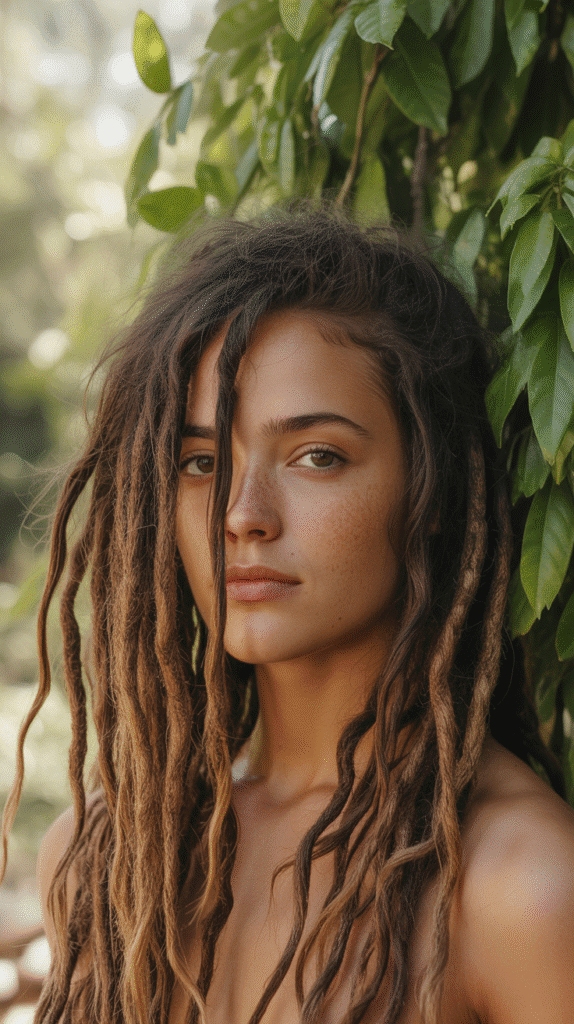
Free-form dreadlocks represent the most organic approach to the loc journey, allowing hair to naturally coil and mat without manipulation or precise sectioning.
This style honors the traditional roots of dreadlocks and creates a beautifully unique pattern that reflects your hair’s natural growth and texture.
- Free-form locs develop through a completely natural process where you simply wash your hair and allow it to form its own sections and patterns without palm rolling, twisting, or interlocking.
- This method produces dreadlocks of varying sizes and shapes, creating an authentically unique look that cannot be replicated, as each person’s hair texture and growth pattern influences the final result.
- The free-form approach requires minimal maintenance in the early stages but demands patience as the locking process can take anywhere from six months to two years depending on hair texture.
- Many people choose this style for its spiritual significance and connection to Rastafarian culture, where the natural formation represents a rejection of societal vanity and artificial manipulation.
- Free-form dreadlocks often result in a fuller, more voluminous appearance compared to manicured locs, making them ideal for those who want a bold, natural statement.
- The maintenance routine focuses primarily on keeping the scalp clean and healthy while allowing the hair to do its natural work without interference or excessive product use.
2. Sisterlocks
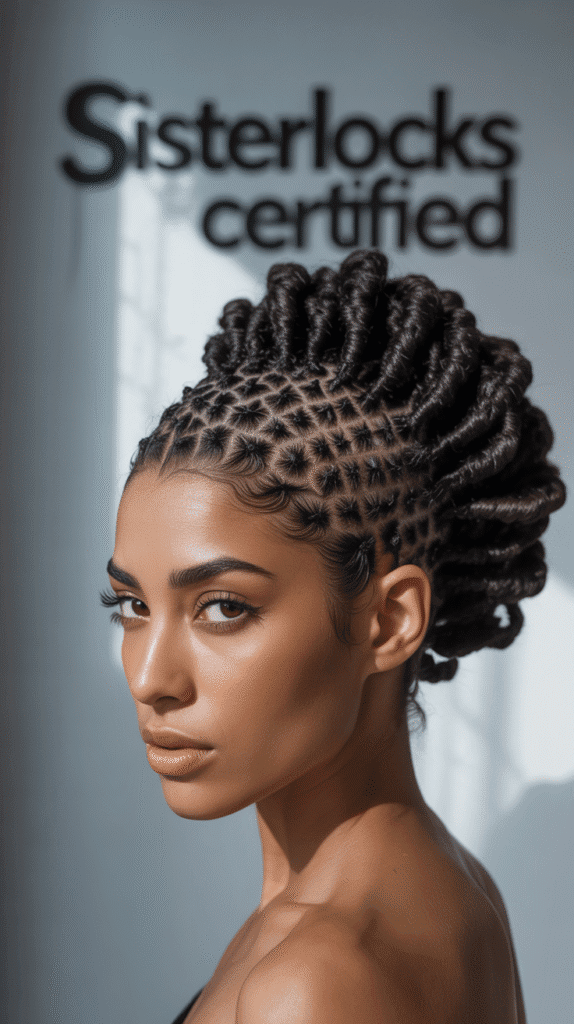
Sisterlocks are a trademarked technique involving tiny, uniform locs created using a specialized tool and precise grid pattern, offering a refined and versatile alternative to traditional dreadlocks.
This style bridges the gap between locked hair and loose natural hair, providing exceptional styling flexibility.
- Sisterlocks must be installed by a certified Sisterlock consultant who creates a customized grid pattern based on your hair texture, density, and desired outcome using a patented interlocking tool.
- The installation process typically takes between 12-24 hours depending on hair length and density, with the stylist creating anywhere from 200 to over 400 individual micro-locs.
- These micro-locs offer unmatched versatility, allowing you to wear your hair straight, curled, in intricate updos, or flowing freely, similar to loose natural hair styling options.
- Maintenance requires retightening every 4-6 weeks, which is less frequent than traditional loc maintenance, though the precision work means appointments can take 2-4 hours.
- Sisterlocks are particularly popular among professionals who want the benefits of locked hair while maintaining a polished, corporate-appropriate appearance that can be styled conservatively or creatively.
- The lightweight nature of sisterlocks makes them comfortable for extended wear and reduces tension on the scalp compared to thicker, heavier traditional locs.
3. High Top Fade with Dreadlocks
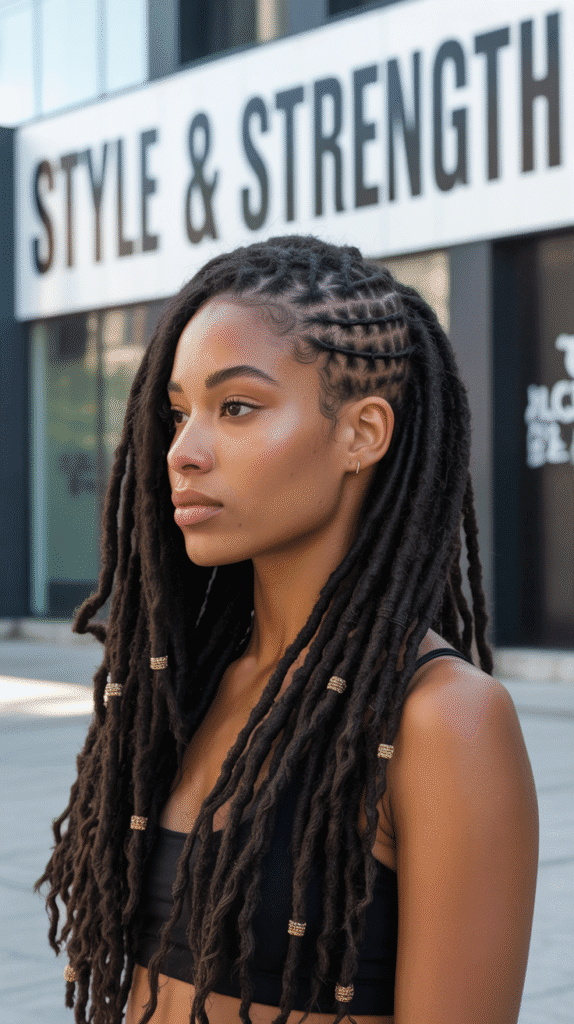
The high top fade with dreadlocks combines the clean, sharp lines of a classic fade with the textured volume of locs on top, creating a striking contrast that has become iconic in urban fashion and hip-hop culture.
This style makes a bold statement while remaining practical and relatively low-maintenance.
- This style requires maintaining two distinct elements: the dreadlocks on top need regular maintenance and retwisting, while the faded sides need frequent barbershop visits every 1-2 weeks to keep lines crisp.
- The contrast between the smooth, short sides and the textured locs creates a dimensional look that draws attention upward, making it particularly flattering for oval and round face shapes.
- High top fades work best with medium to thick hair density, as you need sufficient volume on top to create the dramatic height that defines this style.
- The length of the locs on top can vary from short and stubby (2-4 inches) to long and flowing (6+ inches), with longer versions offering more styling versatility including the option to let them fall forward or to the side.
- This style gained mainstream popularity in the 1980s and 1990s through hip-hop artists and athletes, and has experienced a significant resurgence in recent years with modern variations incorporating designs and patterns in the fade.
- Styling products like loc gel or beeswax can help keep the top locs standing upright for that signature high-top silhouette, though some prefer a more relaxed look where the locs naturally fall.
4. Faux Locs
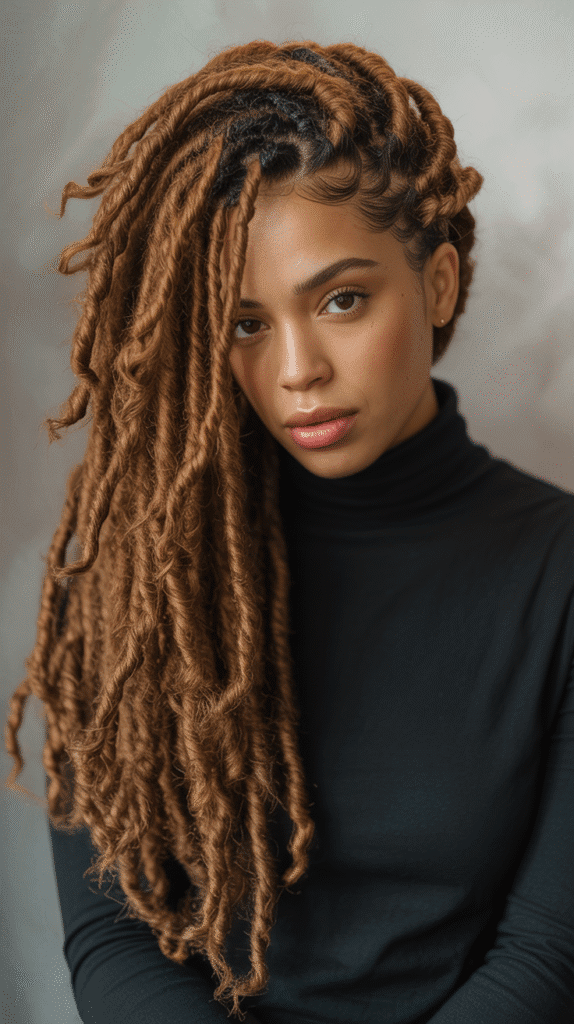
Faux locs provide a temporary way to achieve the dreadlock aesthetic without the long-term commitment, using extensions wrapped around natural hair or braids to create the appearance of mature locs.
This protective style has become increasingly popular for those wanting to test the look or change their appearance temporarily.
- Faux locs can be installed using several methods including crochet technique, wrapping extensions around individual braids, or using pre-made faux loc extensions that attach to cornrowed hair underneath.
- The installation process typically takes 4-8 hours depending on desired length, thickness, and the method used, making it a significant time investment though considerably less than starting real locs from scratch.
- These temporary locs can last anywhere from 4-8 weeks with proper care, allowing you to experiment with the locked look for special occasions, vacations, or to determine if you want to commit to permanent locs.
- Faux locs offer the advantage of choosing your preferred length, thickness, and even color immediately, whereas natural locs require years of growth to achieve similar length and maturity.
- Maintenance involves keeping the scalp clean using a diluted shampoo with an applicator bottle, moisturizing the visible natural hair at the roots, and sleeping with a silk or satin scarf to prevent frizzing.
- The style provides excellent protection for natural hair underneath, allowing it to rest from heat styling and manipulation while promoting growth, though it’s important not to install them too tightly to avoid tension damage.
5. Colored Dreadlocks
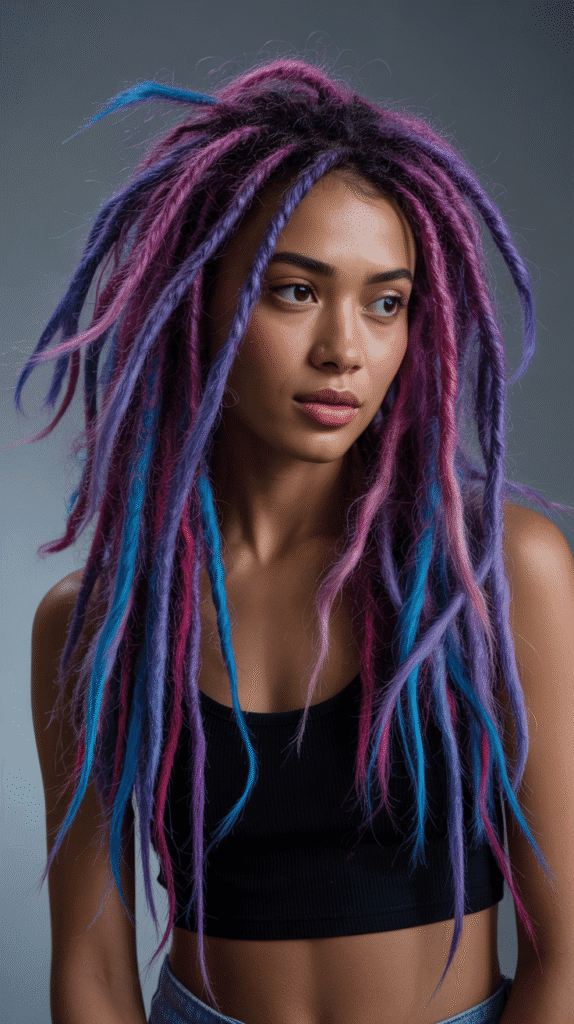
Colored dreadlocks transform traditional locs into vibrant artistic expressions through the use of permanent dyes, semi-permanent colors, or temporary color products.
This trend has exploded in popularity as people embrace dreadlocks as a canvas for creative self-expression.
- Dyeing dreadlocks requires special consideration because the dense, matted structure absorbs and holds color differently than loose hair, often requiring longer processing times and more product to achieve even saturation.
- Lighter colors like blonde, silver, or pastels typically require bleaching, which can weaken the structure of locs if not done carefully, making it essential to work with a colorist experienced in treating locked hair.
- Ombre and balayage techniques have become particularly popular with dreadlocks, creating beautiful gradients from dark roots to lighter or brightly colored ends that grow out gracefully without obvious demarcation lines.
- Semi-permanent and temporary color options including hair chalk, colored wax, and temporary dyes allow for experimentation without permanent commitment, perfect for special events or those who enjoy frequently changing their look.
- Maintaining colored dreadlocks requires specialized care including color-safe shampoos, reduced washing frequency to prevent fading, and deep conditioning treatments to combat the drying effects of chemical color processes.
- Multi-colored dreadlocks featuring rainbow patterns, strategic highlighting, or color blocking have become signature looks for many influencers and artists, using hair as a medium for creative expression and personal branding.
6. Dreadlock Bun
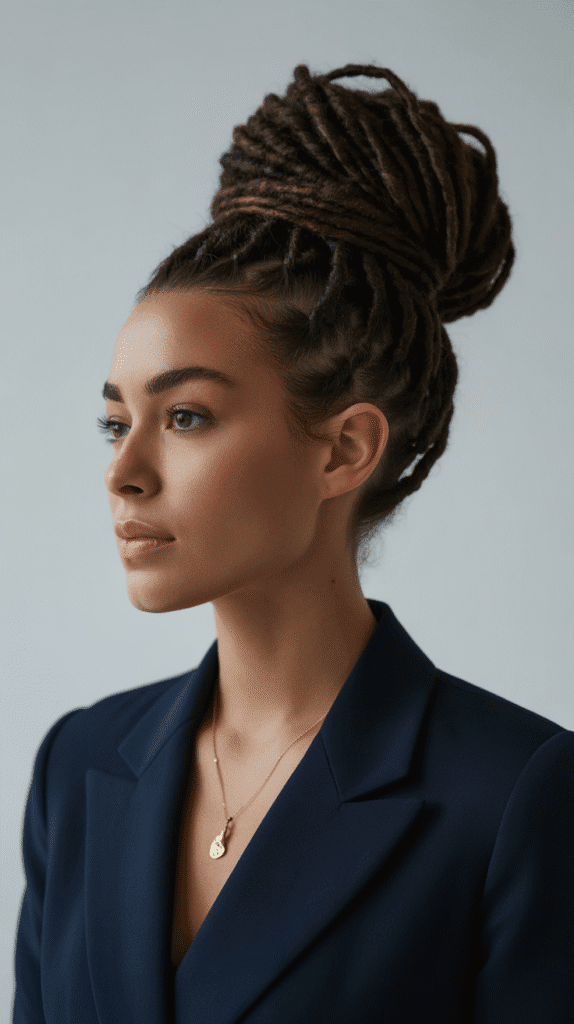
The dreadlock bun is an elegant and practical updo that gathers locs into a single coiled mass at the crown, back, or side of the head, offering a polished appearance suitable for both casual and formal settings.
This timeless style protects the ends of your locs while creating a sophisticated silhouette.
- Creating a dreadlock bun is remarkably simple: gather all locs at your desired location, twist them together, coil the twisted rope around its base, and secure with a hair tie, bobby pins, or decorative hair jewelry.
- The placement of the bun dramatically changes the overall aesthetic—a high bun creates a ballerina-inspired elegance, a low nape bun appears more conservative and professional, while a side bun offers a romantic, bohemian vibe.
- This style works beautifully for locs of various lengths, though medium to long locs (past shoulder length) provide the fullest, most dramatic bun appearance, while shorter locs create a smaller, more understated version.
- Dreadlock buns serve as excellent protective styling by tucking away the ends of your locs, which are the oldest and most fragile parts, reducing exposure to environmental damage and friction from clothing.
- Variations include the messy bun for a casual, effortless look, the sock bun technique for added volume and perfect roundness, or multiple smaller buns for a more playful, artistic appearance.
- Accessorizing with decorative hairpins, flowers, scarves, or beads woven through the bun can transform this simple style from everyday casual to special occasion glamorous.
7. Twisted Dreadlocks
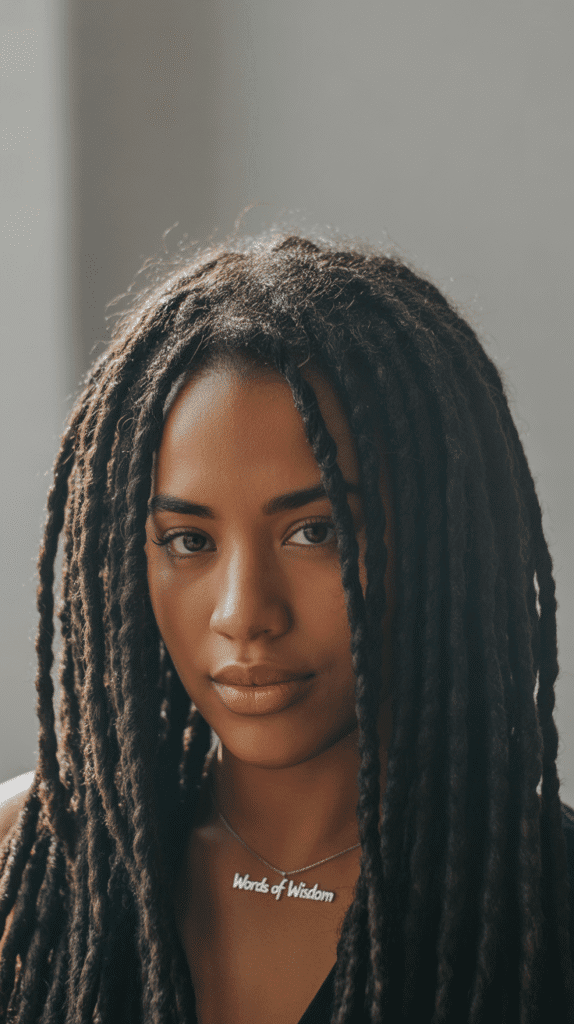
Twisted dreadlocks are formed using the two-strand twist method where sections of hair are divided and twisted around each other before being allowed to lock and mature.
This technique creates a more uniform, rope-like appearance compared to free-form methods.
- The two-strand twist starter method involves sectioning clean hair into squares or triangles, dividing each section in half, and twisting the two pieces around each other from root to tip before securing the end.
- This technique works exceptionally well for all hair types but is particularly effective for type 4 coily hair textures, where the natural curl pattern helps the twists lock together more quickly.
- Twisted locs typically require maintenance every 4-6 weeks where new growth at the roots is retwisted to maintain the neat, uniform appearance and encourage continued locking down the length of each loc.
- The defined spiral pattern created by this method gives dreadlocks a distinctive aesthetic that appears more polished and intentional compared to organic free-form locs, making them popular for professional environments.
- Starting locs with twists generally results in a faster locking process than some other methods, with hair typically beginning to show significant matting and locking within 3-6 months depending on hair texture and maintenance routine.
- Many people choose to eventually stop retwisting and allow their twisted locs to develop a more organic appearance over time, creating an interesting hybrid aesthetic that combines structured roots with free-form body and ends.
8. Dreadlock Ponytail
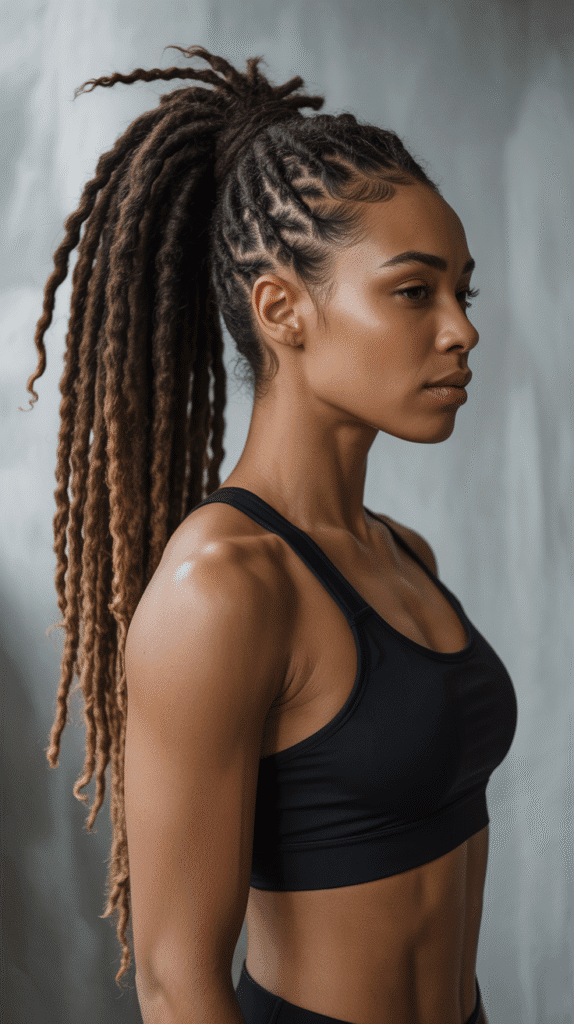
The dreadlock ponytail is a versatile and practical style that pulls all locs back and secures them at various heights, creating a sleek look that highlights facial features while keeping hair controlled and manageable.
This classic style adapts easily from gym wear to evening elegance.
- The height of your ponytail placement significantly impacts the overall vibe: high ponytails convey energy and youthfulness, mid-level ponytails appear balanced and professional, while low ponytails create a more relaxed, sophisticated aesthetic.
- Creating a smooth, sleek ponytail with dreadlocks requires controlling flyaways and baby hairs along the hairline using edge control products or natural alternatives like aloe vera gel for a polished finish.
- For those with very long or heavy dreadlocks, positioning the ponytail too high can create tension and strain on the hairline, making mid-level or low ponytails healthier long-term options that distribute weight more evenly.
- Wrapping one loc around the hair tie creates a polished finishing touch that conceals the elastic band and adds a professional, intentional appearance to the style.
- This style offers excellent versatility for accessorizing with decorative hair cuffs, beads, or wraps placed throughout the ponytail length, allowing you to customize the look for different occasions and personal expressions.
- The dreadlock ponytail serves as an ideal protective style for active lifestyles, keeping locs secure during workouts, swimming (when properly covered), or any activities where loose hair might be impractical.
9. Short Dreadlocks
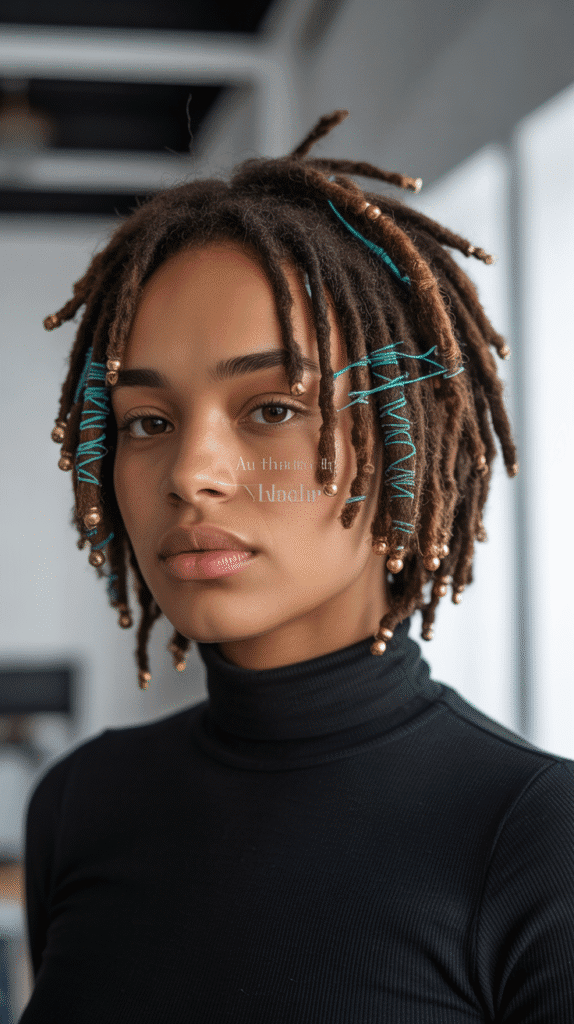
Short dreadlocks typically measure between 2-6 inches in length, offering a low-maintenance, edgy aesthetic that works beautifully for those who prefer manageable hair or are in the early stages of their loc journey.
This length provides surprising versatility despite its compact size.
- Short locs are considerably easier to maintain than longer versions, requiring less time for washing, drying, and styling, while also using significantly less product, making them economical and practical for busy lifestyles.
- This length is perfect for those testing whether dreadlocks suit their personal style and lifestyle, as it represents less commitment than immediately growing long locs, and can be more easily combed out if desired in the early stages.
- Despite their shorter length, these locs still offer styling options including dyeing, adding beads or cuffs near the ends, styling with headbands or durags, and using product to create different textures from spiky to smooth.
- Short dreadlocks are particularly popular in professional environments where a neat, conservative appearance is required, as they appear tidy and well-groomed while still expressing personal style and cultural connection.
- The reduced weight of short locs means less tension on the scalp and hairline, making this length ideal for those concerned about traction alopecia or who have experienced hair loss from heavy, long hairstyles in the past.
- Many people appreciate short locs for warm climates or athletic activities, as they keep the neck cool, dry quickly after washing or sweating, and don’t interfere with sports equipment like helmets or goggles.
10. Dreadlock Mohawk
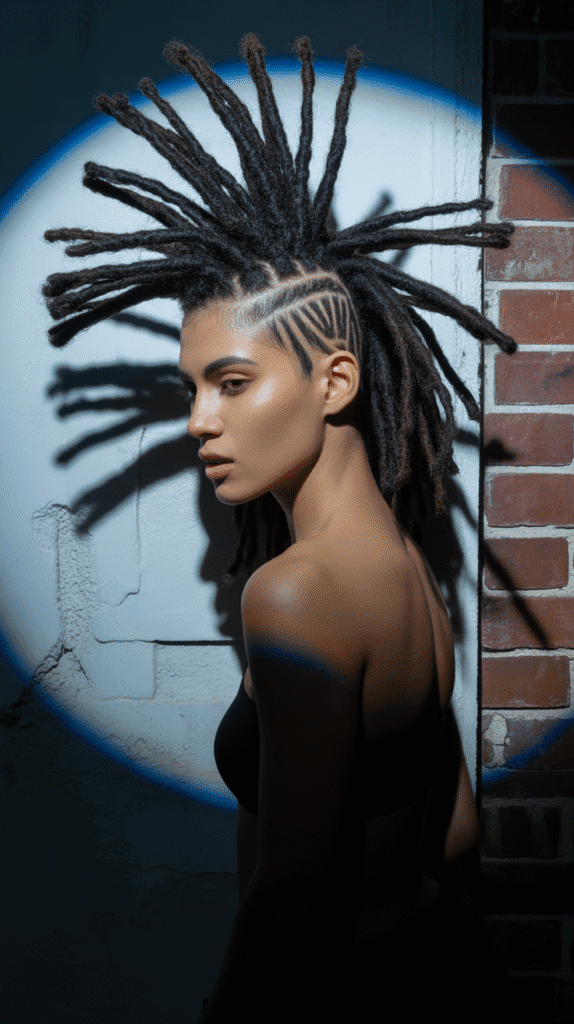
The dreadlock mohawk combines the rebellious punk aesthetic of a traditional mohawk with the texture and cultural significance of dreadlocks, creating a bold statement style.
This look features locs concentrated along the center of the head with shaved or very short hair on the sides.
- Creating this style requires either starting locs only in the center strip of hair while keeping sides shaved, or gradually cutting away existing locs from the sides if transitioning from a full head of dreadlocks.
- The width of the mohawk strip can vary from narrow (2-3 inches) for a more extreme, punk-inspired look to wider (4-6 inches) for a style that appears slightly more conservative while maintaining the mohawk silhouette.
- Styling versatility includes wearing the center locs standing straight up for maximum drama, allowing them to fall to either side for an asymmetrical look, or creating a faux hawk by pulling them all toward the center without product.
- Maintenance involves both regular loc upkeep for the center strip and frequent barbershop visits (every 1-2 weeks) to maintain the clean-shaven sides and any designs or patterns carved into the fade.
- This style has been embraced by various subcultures and has transitioned from underground punk scenes to mainstream fashion, with celebrities and influencers showcasing elegant variations that prove mohawks can be sophisticated.
- The dreadlock mohawk offers an excellent solution for those experiencing hair thinning on the sides, as it intentionally removes hair from these areas while emphasizing the center where growth is typically strongest.
11. Goddess Locs
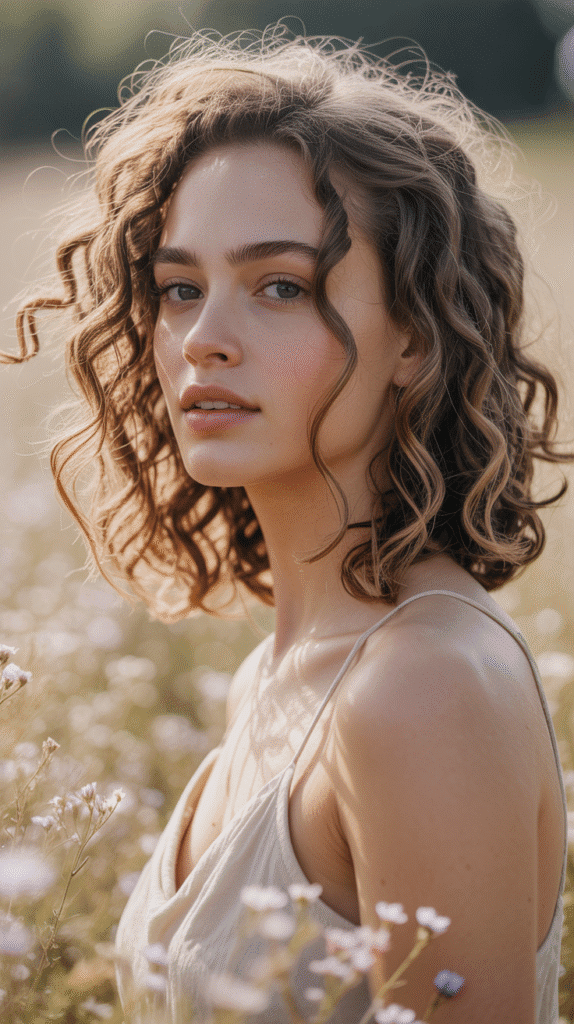
Goddess locs are a softer, more feminine variation of faux locs characterized by wavy or curly ends left loose rather than sealed, creating a romantic, bohemian aesthetic.
This protective style has gained massive popularity for its beautiful, effortless appearance.
- Unlike traditional faux locs with sealed ends, goddess locs intentionally leave several inches of the extension unraveled, creating soft curls or waves that add movement, dimension, and a more natural, lived-in appearance.
- Installation typically uses the crochet method with pre-looped goddess loc extensions, making the process faster (4-6 hours) compared to individually wrapped faux locs, though hand-wrapping methods are also used for a more customized look.
- The amount of loose hair at the ends can be customized based on personal preference, ranging from subtle wisps of 1-2 inches to dramatic, flowing curls extending 4-6 inches or more beyond the wrapped portion.
- These locs photograph beautifully and have become extremely popular on social media platforms, making them a favorite choice for content creators, brides, and anyone attending special events who wants an elegant, eye-catching hairstyle.
- Maintenance focuses on preserving the curly ends by using mousse or curl-defining products, sleeping with a silk or satin bonnet or scarf, and occasionally refreshing the curls with water and product to maintain their definition.
- Goddess locs can last 4-8 weeks depending on hair growth rate, installation quality, and maintenance routine, offering an extended protective style that gives natural hair underneath a break from daily manipulation.
12. Butterfly Locs
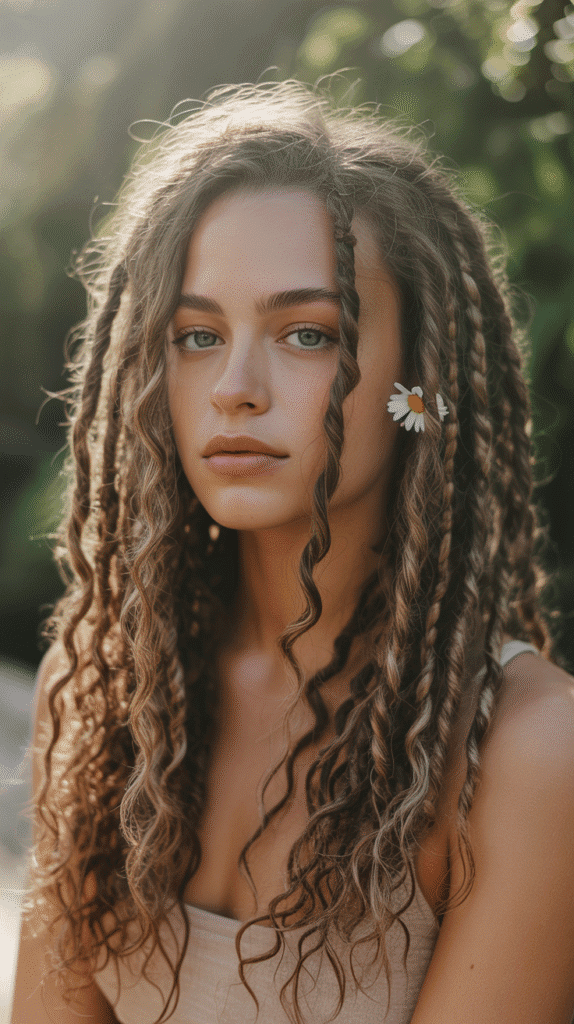
Butterfly locs are a distressed, bohemian style of faux locs characterized by a purposefully messy, unraveled appearance with loops and loose sections throughout the length.
This intentionally imperfect aesthetic creates a soft, romantic look that appears naturally weathered.
- The signature characteristic of butterfly locs is their deliberately imperfect wrapping technique, where the extension hair is not tightly sealed, allowing loops, bumps, and loose sections to emerge naturally throughout the length.
- Installation involves cornrowing the natural hair, then using a crochet needle to loop extension hair through the braids before wrapping it loosely, intentionally creating the distressed texture that defines this style.
- This style typically takes 5-8 hours to install depending on desired length and thickness, falling between the time requirements of neat faux locs and quicker goddess locs.
- Butterfly locs offer a more lived-in, natural appearance compared to perfectly wrapped faux locs, making them ideal for those who prefer effortless, bohemian aesthetics over polished, uniform looks.
- The lightweight nature of butterfly locs, combined with their airy, open structure, makes them more comfortable than dense, tightly wrapped alternatives, reducing tension on the scalp and neck.
- These locs can last 6-10 weeks with proper care, though some of the loose sections may unravel further over time, which actually enhances the intentionally distressed aesthetic rather than detracting from it.
13. Interlock Dreadlocks
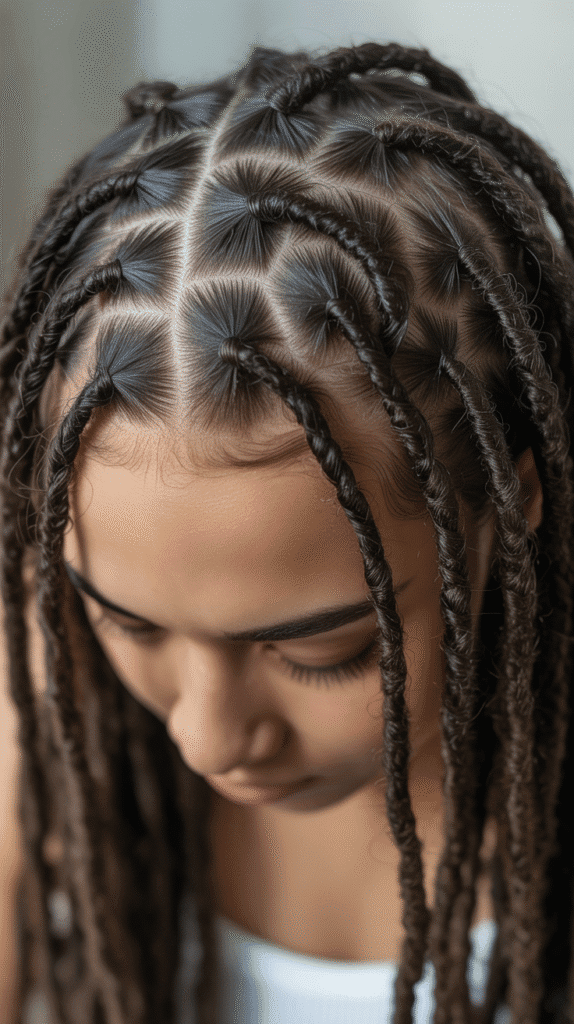
Interlocking is a maintenance technique where the end of each loc is pulled through its own root using a tool or by hand, creating a locked base that holds firmly without the need for twisting products.
This method produces extremely tight, uniform locs with exceptional longevity.
- The interlocking process involves dividing new growth at the root into four quadrants and pulling the end of the loc through the center of these quadrants in a consistent pattern, creating a locked foundation that won’t unravel.
- This method is particularly effective for hair types that don’t naturally lock easily, including straighter textures, fine hair, or multi-textured hair, as it mechanically creates the locked structure regardless of natural curl pattern.
- Interlocked locs require maintenance every 6-8 weeks, less frequently than twisted locs, because the locked structure holds more securely and doesn’t rely on reformed twists to maintain the loc integrity.
- The resulting locs are extremely durable and uniform, with a tightly compacted structure that produces cylindrical, rope-like locs rather than the flatter, more organic shapes that can develop with other methods.
- One consideration with interlocking is the potential for thinning over time if done too tightly or too frequently, as the repetitive pulling through the same holes can eventually weaken the hair structure, making proper technique crucial.
- This method is ideal for those who want low-maintenance locs with maximum structure and uniformity, particularly people with active lifestyles who swim frequently or live in humid climates where other methods might not hold as well.
14. Dreadlock Half-Up Half-Down
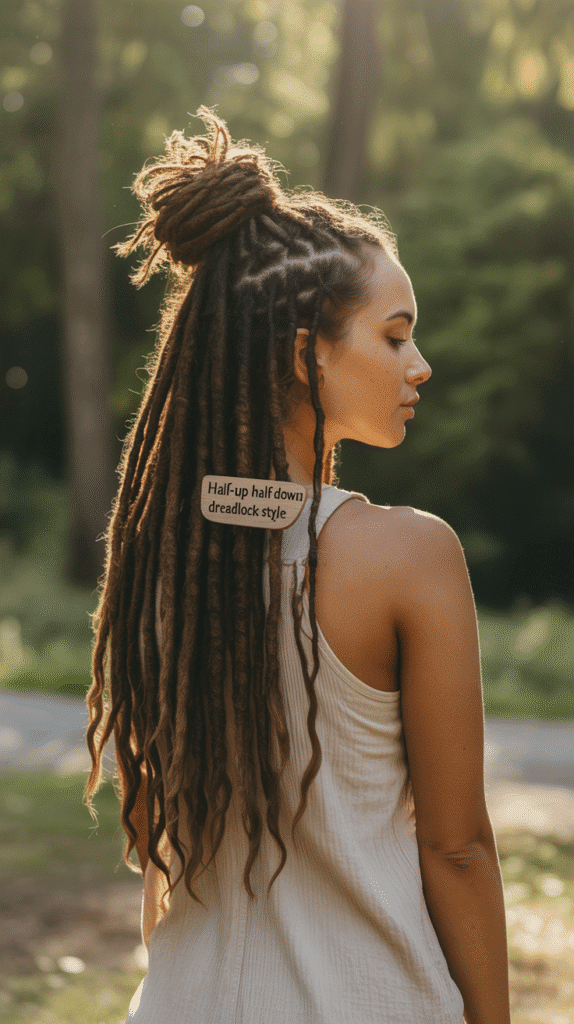
The half-up half-down dreadlock style combines the elegance of an updo with the flowing beauty of loose locs, creating a balanced, versatile look suitable for numerous occasions.
This style pulls the top section of locs away from the face while leaving the remaining locs to cascade down the back and shoulders.
- This style is created by sectioning the locs horizontally across the head from ear to ear, gathering the top section, and securing it with a hair tie, clip, or creating a bun or twist, while the bottom section remains loose.
- The versatility of this style allows for numerous variations: a simple ponytail, an elegant bun, twisted rope detail, braided top section, or multiple smaller sections creating patterns across the crown area.
- Half-up half-down styling is particularly flattering for heart-shaped and oval faces as it adds volume at the crown while framing the face with the loose locs that remain down, creating balanced proportions.
- This practical style keeps hair out of your face for work, exercise, or daily activities while maintaining the aesthetic appeal and movement of loose, flowing dreadlocks, offering functionality without sacrificing style.
- Accessorizing options are extensive, including decorative hair sticks or pins at the secured section, beads or cuffs throughout the loose locs, or hair jewelry that creates visual interest at the division point between up and down sections.
- The style works beautifully for all loc lengths, though medium to long locs (shoulder length or longer) create the most dramatic effect, while shorter locs produce a cute, youthful version of the same concept.
15. Blonde Dreadlocks
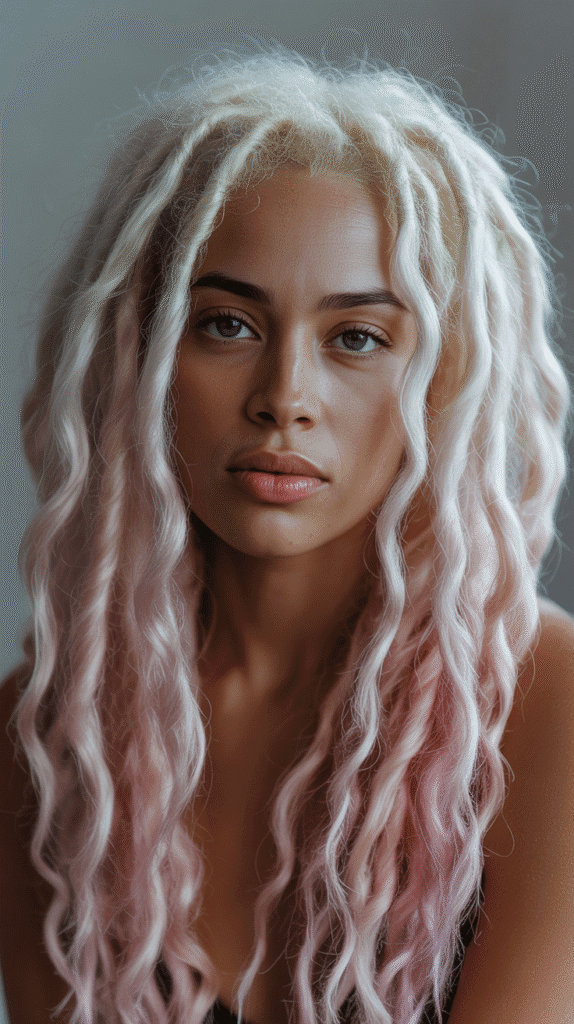
Blonde dreadlocks create a striking, sun-kissed appearance that ranges from platinum white to honey gold, offering a dramatic transformation that’s both trendy and timeless.
This bold color choice has been embraced across cultures and continues to be a popular statement look.
- Achieving blonde dreadlocks typically requires bleaching, which is a more complex process with locked hair than loose hair because the dense structure requires more product, longer processing time, and careful saturation to ensure even color throughout each loc.
- The bleaching process should ideally be done by a professional colorist experienced with dreadlocks, as improper technique can lead to breakage, uneven color with darker cores, or damage to the loc structure that causes thinning or weakness.
- Different blonde shades create dramatically different aesthetics: platinum or white blonde makes a bold, high-fashion statement; golden blonde appears warm and natural; honey or caramel blonde adds sun-kissed dimension without extreme contrast.
- Maintaining blonde dreadlocks requires specialized care including purple or blue-toning shampoos to prevent brassiness, deep conditioning treatments to combat dryness from chemical processing, and minimizing sun exposure which can cause fading or orange tones.
- The contrast between blonde locs and darker skin tones creates a stunning visual effect that’s become iconic in fashion and entertainment, while blonde locs on lighter skin tones create a softer, more natural-looking aesthetic.
- Blonde dreadlocks require more frequent color maintenance than blonde loose hair because the loc structure makes new growth more visible, typically needing root touch-ups every 6-8 weeks to maintain a cohesive color throughout.
16. Thick Dreadlocks
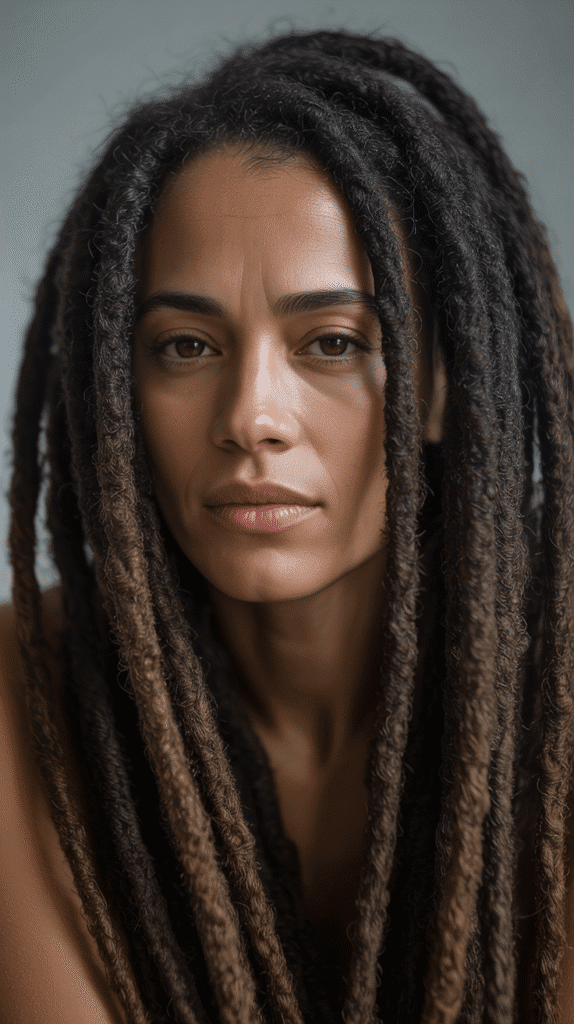
Thick dreadlocks feature larger sections of hair, typically ranging from one to two inches in diameter, creating a bold, substantial look with fewer but more dramatic individual locs.
This style makes a strong visual statement while being surprisingly practical for maintenance.
- Thick locs are created by sectioning hair into larger squares or circles during the initial stages, with sections typically measuring 1-2 inches across, resulting in a full head having anywhere from 40-80 locs compared to 100-200+ for thinner locs.
- These substantial locs lock and mature more slowly than thinner versions because of the increased hair volume that must mesh together, often requiring 12-18 months before reaching full maturity compared to 6-12 months for thinner locs.
- The weight of thick dreadlocks creates natural downward pull that results in elegant, flowing movement and less tendency toward frizzy flyaways, though this weight can also create more tension on the scalp if not properly maintained.
- Maintenance is actually simpler with thick locs because there are fewer individual locs to wash, dry, retwist, or style, making them ideal for people who want the loc aesthetic without spending extensive time on hair care.
- Thick locs have a bold, statement-making appearance that reads as confident and intentional, making them popular among artists, musicians, and those who embrace maximalist personal style rather than minimalist aesthetics.
- One consideration with thick locs is that they take significantly longer to dry after washing compared to thinner locs, sometimes requiring several hours of air drying or extended time under a hooded dryer to ensure the centers dry completely.
17. Thin Dreadlocks
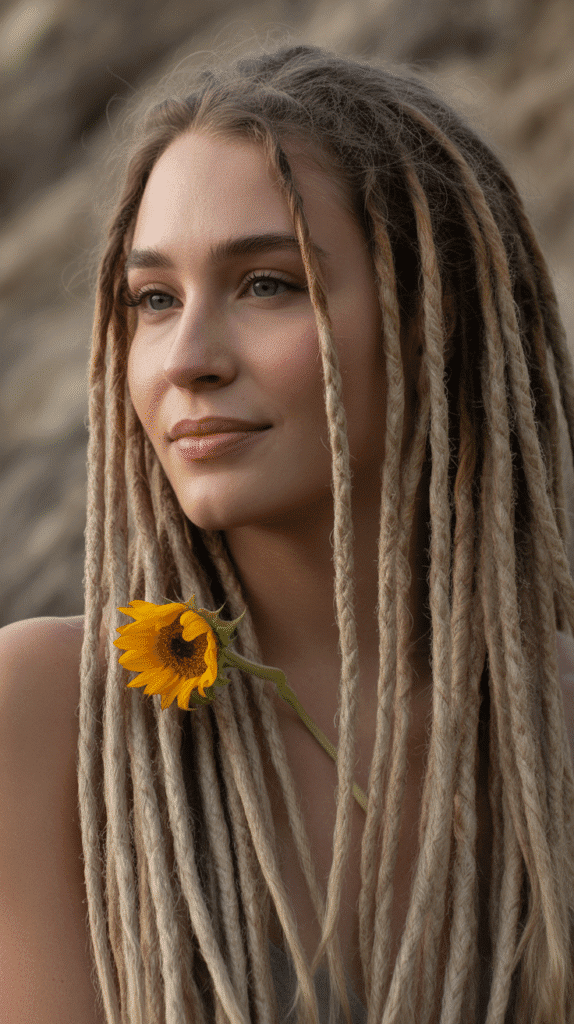
Thin dreadlocks feature delicate, pencil-sized or smaller locs created from small sections of hair, resulting in numerous individual locs that offer exceptional styling versatility and a more refined aesthetic.
This style has gained popularity for its elegant appearance and flexibility.
- Thin locs are sectioned very small during installation, typically between 0.25-0.5 inches square, resulting in a full head containing 150-300+ individual locs depending on hair density and desired thickness.
- These smaller locs lock considerably faster than thicker ones because less hair needs to mesh together, often reaching mature locked status within 6-10 months compared to the year or longer required for thick locs.
- The abundance of individual locs creates exceptional styling versatility, allowing for intricate braided patterns, complex updos, detailed hair jewelry arrangements, and styles that would be impossible with thicker, fewer locs.
- Thin dreadlocks weigh less individually and distribute weight more evenly across the scalp, reducing tension on any single area and potentially causing less strain on the hairline compared to heavy, thick locs.
- The aesthetic of thin locs appears more refined and polished, making them popular in professional environments where a neater, more conservative appearance is valued while still maintaining personal style expression.
- Maintenance requires more time because each individual loc needs attention during retwisting or interlocking sessions, potentially adding 1-2 hours to maintenance appointments compared to a comparable head of thick locs.
18. Braided Dreadlock Styles
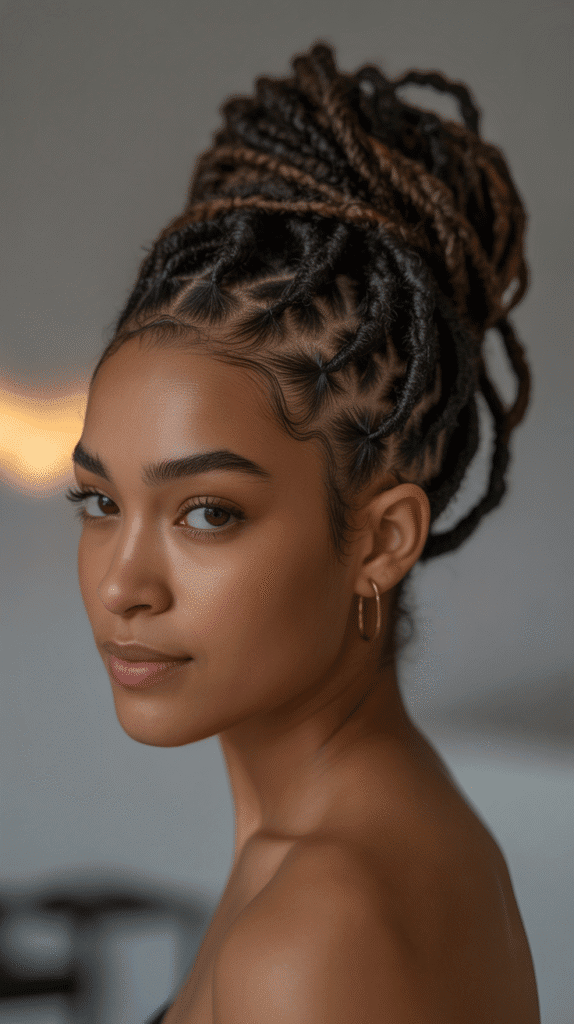
Braided dreadlock styles incorporate traditional braiding techniques with locked hair, creating intricate patterns and designs that showcase both the texture of locs and the artistry of braiding.
This combination offers sophisticated styling possibilities that elevate dreadlocks to artistic expression.
- Various braiding techniques can be applied to dreadlocks including simple three-strand braids using multiple locs together, cornrow patterns across the scalp using locs instead of loose hair, or fishtail braids for a more intricate appearance.
- The number of locs incorporated into each braid dramatically affects the final appearance: using 2-3 locs creates delicate, detailed braids, while incorporating 5-10 locs produces substantial, rope-like braided sections with bold visual impact.
- Braided dreadlock styles often combine multiple techniques in one look, such as cornrowed locs along the sides leading into a braided bun at the crown, or a braided crown circling the head with remaining locs flowing loose.
- These styles offer excellent protection for loc ends by securing them within the braided structure, making braided styles both aesthetically pleasing and functionally protective for maintaining healthy dreadlocks.
- The complexity of braided dreadlock styles makes them ideal for special occasions, professional photo shoots, weddings, or any event where an elaborate, attention-grabbing hairstyle is desired.
- Learning to braid your own locs takes practice because their cylindrical, slippery texture behaves differently than loose hair, but once mastered, creates unlimited creative possibilities for self-styling without requiring salon visits.
19. Ombre Dreadlocks
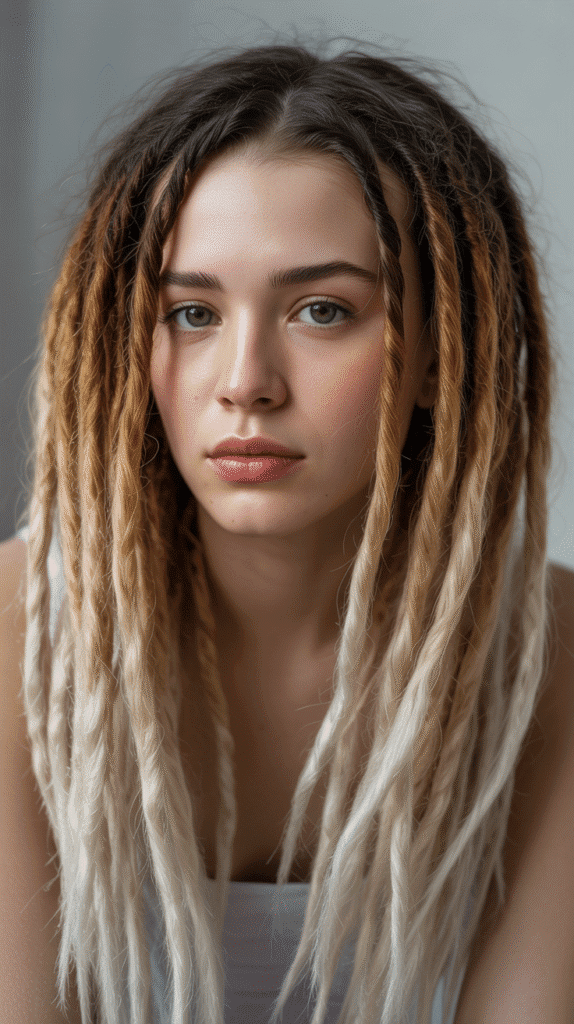
Ombre dreadlocks feature a gradual color transition from darker roots to lighter ends, creating a dimensional, sun-kissed effect that adds visual interest and depth.
This coloring technique has become increasingly popular for its modern aesthetic and relatively low maintenance as it grows out.
- The ombre effect on dreadlocks typically involves bleaching the bottom half to two-thirds of the locs while leaving roots natural, then potentially toning or dyeing the lightened sections to achieve the desired end color.
- Creating smooth color transitions in dreadlocks requires careful application because the dense structure can cause harsh lines if the bleach is not properly blended, making professional application highly recommended for seamless gradients.
- The beauty of ombre coloring is that it grows out gracefully without creating obvious demarcation lines at the roots, allowing for longer periods between color maintenance appointments compared to all-over color or highlights.
- Popular ombre combinations include natural black to blonde, brown to caramel, dark brown to burgundy, or black to vibrant fashion colors like blue, purple, or pink for more adventurous looks.
- Maintenance focuses primarily on the colored portions, requiring color-safe products, periodic toning to maintain desired shades, and deep conditioning treatments to address the dryness that bleached or colored hair naturally experiences.
- The dimensional effect of ombre adds visual movement and interest to dreadlocks, making them appear more dynamic in photos and in person, as the color variation catches light differently throughout the length.
20. Dreadlock Bob
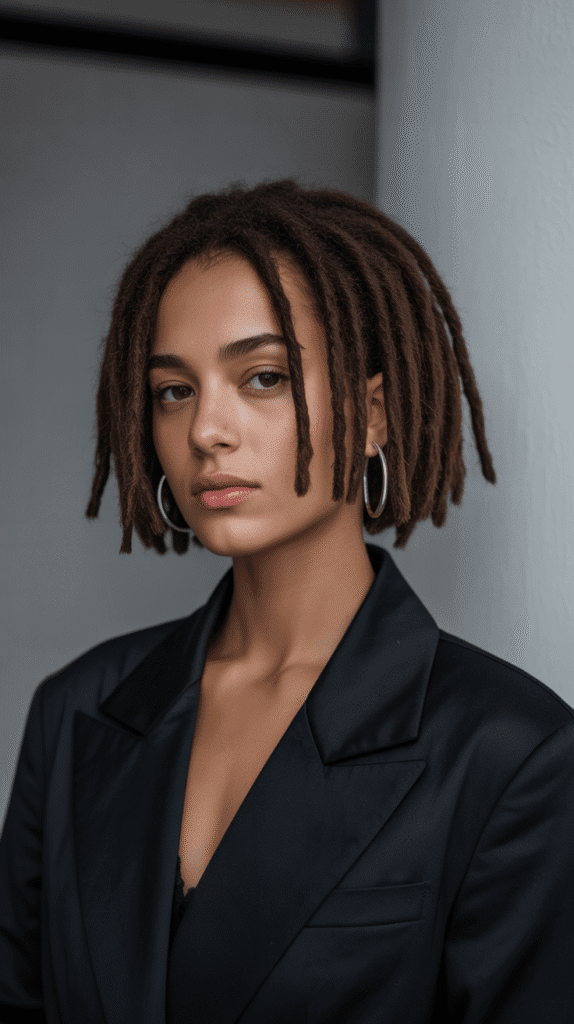
The dreadlock bob features locs cut to chin or shoulder length, creating a chic, manageable style that combines the edginess of dreadlocks with the classic sophistication of a bob haircut.
This length offers a modern twist on both traditional locs and conventional bob styles.
- Creating a dreadlock bob can be done by either starting locs on shorter hair or cutting existing long locs to the desired length, with most people choosing to cut established locs for the instant gratification of the finished look.
- The length typically ranges from chin-length (around 6-8 inches) to shoulder-length (10-12 inches), with the specific measurement depending on face shape, neck length, and personal aesthetic preferences.
- This style dramatically reduces maintenance time, drying time, and product usage compared to longer locs, making it extremely practical for busy lifestyles while maintaining the cultural and aesthetic significance of dreadlocks.
- The loc bob can be blunt cut for a sharp, fashion-forward appearance or layered and textured for a softer, more organic look, with some people choosing to keep slightly longer locs in front for face-framing effects.
- Styling versatility includes wearing it straight down for a sleek appearance, tucking one side behind the ear for asymmetry, adding texture with loc butter or cream, or creating small updos and pinned styles despite the shorter length.
- This length is particularly flattering for people with long necks and works beautifully with all face shapes when customized appropriately, with slightly longer versions suiting round faces and shorter versions complementing longer face shapes.
21. Starter Locs (Baby Locs)
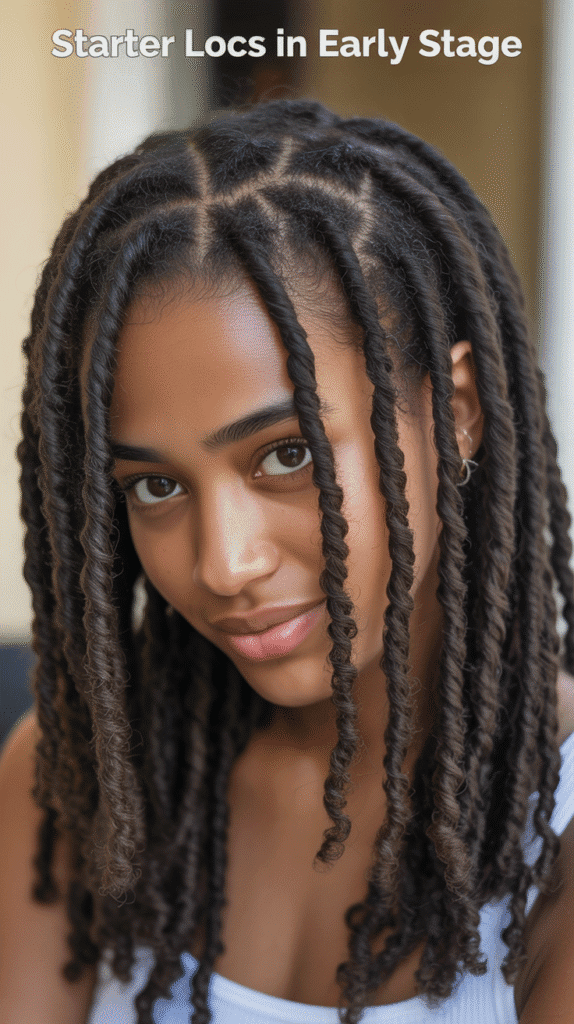
Starter locs, often called baby locs, represent the beginning phase of the dreadlock journey when hair has just been sectioned and begun the locking process but hasn’t yet fully matured.
Understanding and embracing this stage is crucial for successful loc development.
- Starter locs typically span the first 3-6 months of the loc journey, characterized by their neat, defined appearance that hasn’t yet developed the mature, fully locked texture that comes with time and proper maintenance.
- Several methods can initiate starter locs including two-strand twists, coils (also called comb coils), braids, interlocking, or simply allowing hair to freeform, with each method producing slightly different aesthetics and locking timelines.
- During this vulnerable phase, locs are still forming their internal structure and may partially or fully unravel if not properly maintained, making it crucial to follow recommended washing schedules and avoid excessive manipulation.
- The appearance of starter locs changes week by week as hair begins to bud, fuzz, and eventually matt together, with this transformation looking messy or unkempt to some, though it’s actually a healthy sign of proper loc development.
- Patience is the most important virtue during the starter loc phase, as many people become discouraged by the awkward transitional appearance and consider giving up before their locs have the opportunity to mature into beautiful, fully formed locks.
- Maintenance during this stage focuses on keeping the scalp clean without over-washing, avoiding heavy products that prevent locking, and periodic re-twisting or palm rolling to encourage the hair to continue forming into distinct, separated locs.
- Baby locs require gentle handling during sleep, with many people choosing to wear satin or silk bonnets, durags, or sleeping on silk pillowcases to minimize friction that could cause unraveling or frizz during these formative months.
22. Crochet Dreadlocks
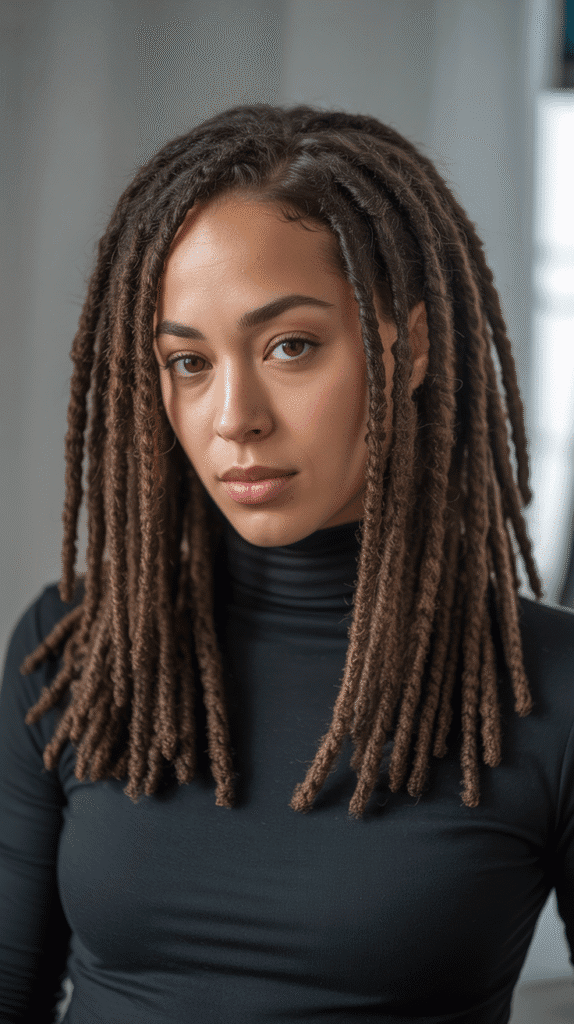
Crochet dreadlocks utilize a latch hook or crochet needle to pull loose hairs into the body of each loc, creating an extremely neat, maintained appearance with minimal loose hair or frizz.
This maintenance technique produces some of the tidiest, most uniform dreadlocks possible.
- The crochet method involves using a small hook (typically 0.5-0.75mm) to catch stray hairs around and along the loc, then pulling them through and into the center of the loc, effectively “tucking in” all loose hairs for a polished finish.
- This technique can be used during initial loc creation or as an ongoing maintenance method, with many people combining it with other techniques like interlocking at the roots and crochet hooking along the length for comprehensive tidiness.
- Crochet maintenance creates the cleanest, most defined locs with sharp, smooth appearances that photograph beautifully and maintain professional aesthetics, making this method popular among those in corporate environments or public-facing careers.
- The primary concern with excessive crochet maintenance is potential thinning and weakening of locs if done too aggressively or too frequently, as constantly pulling hairs through the loc structure can eventually cause breakage and compromise loc integrity.
- Sessions can be time-intensive, often requiring 2-4 hours or more for a full head depending on loc quantity and length, though results typically last 6-8 weeks before significant loose hairs reappear.
- Many loc maintenance specialists recommend limiting crochet hook use to specific areas that need it most, such as the hairline or crown where neatness is most visible, while allowing other areas to develop more naturally for healthier overall loc development.
23. Loc Extensions
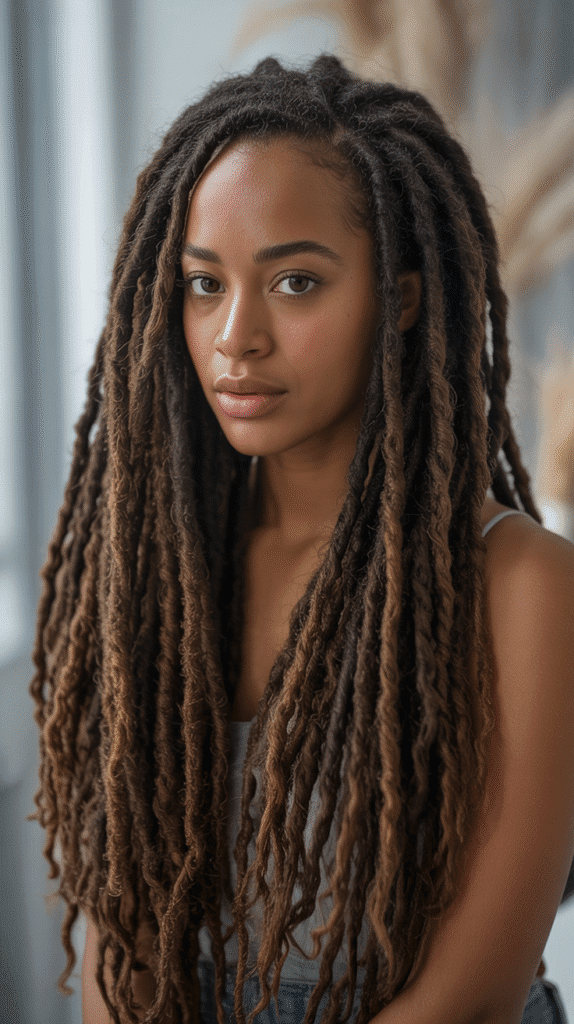
Loc extensions add instant length, volume, or thickness to existing dreadlocks by attaching pre-made or custom-created locs to your natural locs or braided natural hair.
This method offers immediate transformation without waiting years for natural growth.
- Several attachment methods exist including braiding extension locs directly onto natural locs, using loc extensions as a protective style over cornrowed natural hair, or wrapping extension hair around existing locs for added thickness.
- Human hair extensions provide the most natural appearance and can be styled, colored, and maintained like natural locs, while synthetic options like kanekalon or marley hair offer more affordable alternatives with vibrant color options.
- The installation process typically takes 4-8 hours depending on the number of extensions being added, the attachment method chosen, and whether you’re adding extensions to existing locs or creating an entirely new protective style.
- Loc extensions can remain in place for 8-12 weeks when properly maintained, with some methods lasting even longer, allowing your natural hair underneath to rest and grow while you enjoy the aesthetic of longer locs.
- This option is ideal for people who want to experience long locs immediately, need temporary length for special occasions like weddings or photo shoots, or want to test whether long locs suit their lifestyle before committing to years of growth.
- Proper removal is crucial to avoid damaging natural locs underneath, requiring careful unwrapping or cutting of the extension attachment while preserving your natural hair, making professional removal highly recommended especially for first-time users.
24. Dreadlock Crown
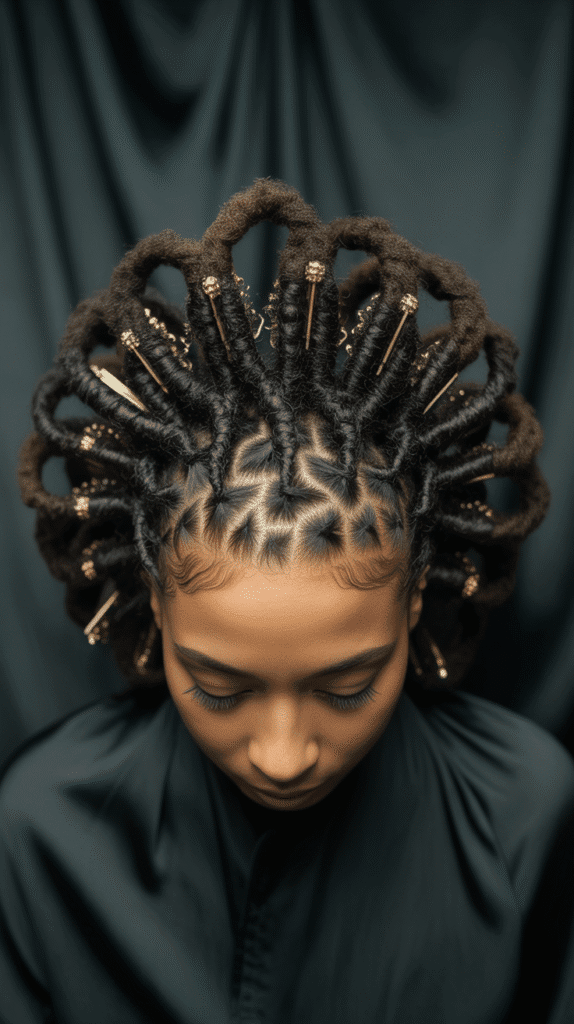
The dreadlock crown is an elegant updo where locs are arranged in a circular pattern around the head, creating a halo or crown effect that sits regally atop the head.
This sophisticated style has ancient roots and remains timelessly beautiful for formal occasions.
- Creating a crown typically involves sectioning locs into manageable portions, twisting or braiding them, then carefully pinning them in a circular pattern around the perimeter of the head, with the center either left open or filled with a bun.
- This style works best with medium to long locs (shoulder length or longer) that have enough length to wrap around the head at least once, though shorter locs can create modified versions with smaller crown circumferences.
- The dreadlock crown offers excellent versatility for formal events, with simple versions appropriate for professional settings and elaborately decorated versions perfect for weddings, cultural celebrations, or artistic performances.
- Securing the crown requires strategic use of bobby pins, hair pins, or decorative hair accessories that both hold the style in place and add visual interest, with placement requiring practice to ensure the crown sits evenly and securely.
- This protective style tucks away all loc ends, shielding them from environmental damage, friction, and manipulation, making it both beautiful and functional for maintaining healthy dreadlocks while looking spectacular.
- Variations include the twisted crown where locs are twisted together before being arranged, the braided crown featuring braided sections, or the stacked crown where multiple layers of locs are pinned at different heights for added dimension.
25. Undercut with Dreadlocks
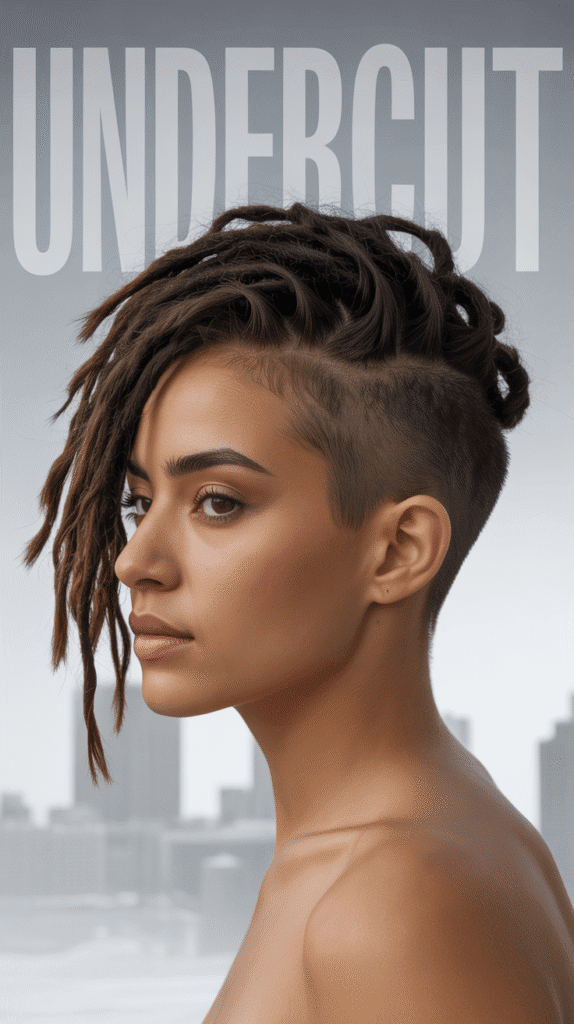
The undercut with dreadlocks features closely shaved or buzzed hair on the sides and/or back of the head with dreadlocks maintained on top, creating dramatic contrast and an edgy, contemporary aesthetic.
This style reduces hair volume while maintaining the loc aesthetic where it’s most visible.
- The undercut can be subtle with a small shaved section hidden beneath longer locs, or dramatic with extensive shaving that leaves locs only on the crown and front sections, allowing for customization based on personal comfort and style preferences.
- This style provides relief for those who find full heads of dreadlocks too heavy or hot, especially in warm climates, by significantly reducing hair volume while maintaining the signature loc aesthetic in prominent, visible areas.
- Maintenance requires both regular loc care for the remaining dreadlocks and frequent barbershop visits (every 2-3 weeks) to maintain the clean, sharp lines of the shaved sections, making it more maintenance-intensive than either style alone.
- The undercut with locs has become particularly popular among women and non-binary individuals as a way to incorporate edgy, typically masculine styling elements while maintaining feminine or androgynous presentations through styling of the remaining locs.
- Styling versatility allows the remaining locs to be worn down to showcase the undercut, pulled up to fully reveal the shaved sections, or styled to partially conceal the undercut for more conservative settings when needed.
- Designs, patterns, or even artwork can be shaved into the undercut sections, turning the hairstyle into a canvas for creative expression that can be changed regularly as hair grows and is re-cut.
26. Barrel Twist Locs
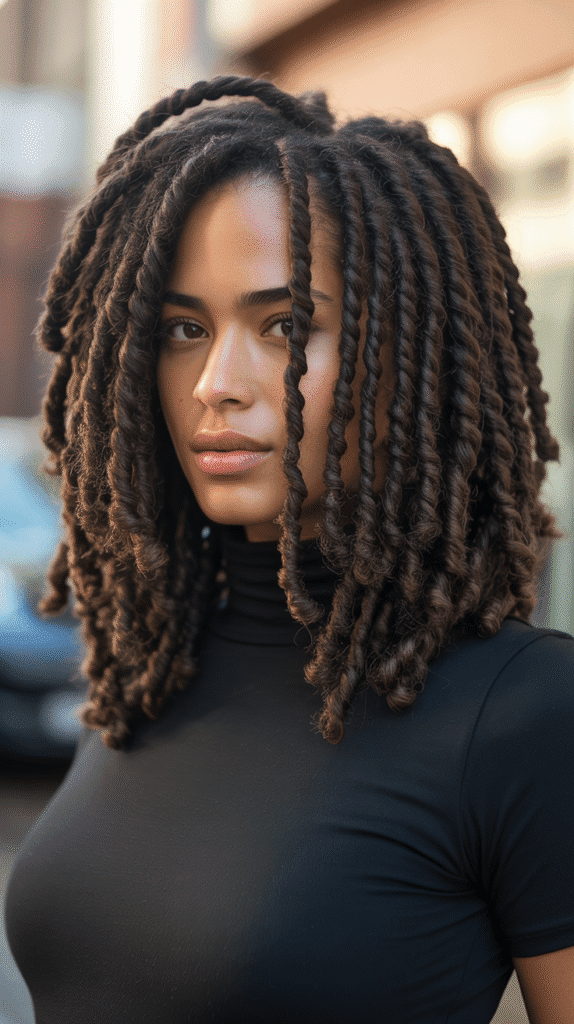
Barrel twist locs feature a distinctive spiral pattern created by consistently twisting two locs together along their entire length, producing a thick, rope-like appearance with clearly defined twist definition.
This style offers a unique textural variation on traditional dreadlocks.
- Creating barrel twists involves taking two separate locs and twisting them around each other from root to tip, with some people choosing to twist two locs temporarily as a style, while others allow the twists to eventually merge into single, thicker locs.
- The technique creates a beautiful, defined spiral texture that adds visual interest and dimension, with the twisted pattern catching light differently than straight locs and creating dynamic movement when the hair moves.
- Barrel twists can be done with locs of similar thickness for uniform appearance or intentionally mixed sizes for a more organic, varied aesthetic, with each approach creating distinctly different visual effects.
- This styling method serves as both a protective style by enclosing two locs together and reducing individual exposure to elements, and as a way to temporarily reduce the number of locs someone has if they’re transitioning to thicker locs.
- The twists can be maintained as a permanent style through periodic re-twisting at the roots, or left to eventually combine and loc together as one, with the timeline for complete merging typically taking 6-12 months depending on hair texture.
- Barrel twist locs create a fuller, more voluminous appearance compared to individual locs of the same total hair quantity, making this technique popular for people who want a bolder, more substantial loc aesthetic.
27. Decorated Dreadlocks
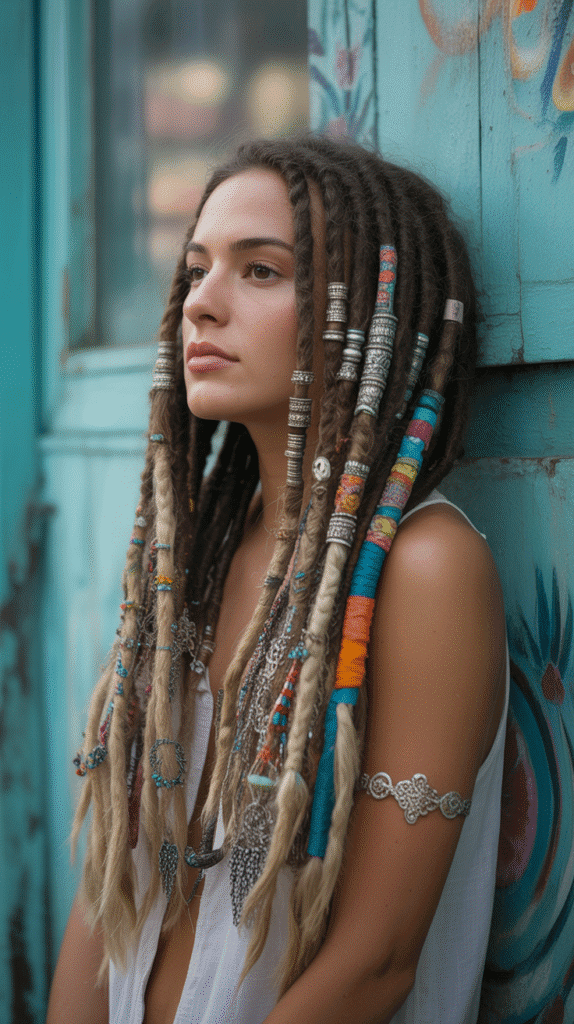
Decorated dreadlocks incorporate jewelry, beads, wraps, cuffs, and other ornamental accessories throughout the locs, transforming them into wearable art that expresses personal style, cultural heritage, or artistic vision.
This customization approach makes each person’s locs truly unique.
- Traditional decorations include wooden, metal, or glass beads that slide onto individual locs, available in countless colors, sizes, and designs ranging from simple solid colors to intricate carved patterns or meaningful symbols.
- Metal loc cuffs and rings wrap around the circumference of locs at various points, adding metallic accents that can be stacked, spread throughout the length, or concentrated at specific areas like near the roots or at the ends.
- Thread wrapping or yarn wrapping involves tightly winding colored thread, yarn, or embroidery floss around sections of locs, creating colorful bands of decoration that can incorporate multiple colors in patterns, stripes, or gradients.
- Cowrie shells hold deep cultural significance in many African and Caribbean traditions and are frequently incorporated into dreadlock decoration, often combined with beads and other natural materials for meaningful, heritage-honoring adornment.
- Seasonal or occasion-specific decorations allow for constantly evolving aesthetics, with people changing their loc jewelry for holidays, cultural celebrations, personal milestones, or simply when they desire a fresh look without changing their actual hairstyle.
- The key to successful decoration is ensuring that beads and jewelry are properly sized for your loc thickness—too tight causes thinning and breakage, too loose causes slipping and loss—and limiting decoration weight to avoid unnecessary tension on the scalp and hairline.
Conclusion
Throughout this exploration of 27 Latest Dreadlock Styles That Are Trendy and Timeless, we’ve discovered that dreadlocks offer far more versatility, creativity, and personal expression than many people realize.
From the organic beauty of free-form locs to the precision of sisterlocks, from bold mohawks to elegant crowns, from natural colors to vibrant hues, the world of dreadlocks encompasses styles suitable for every personality, lifestyle, and aesthetic preference.
Whether you’re drawn to the cultural and spiritual significance of traditional locs, the practical benefits of protective styling with faux variations, or the artistic possibilities of decorated and colored locs, there’s a dreadlock style that can authentically represent who you are.
The beauty of choosing dreadlocks lies not just in the finished style but in embracing the journey of growth, patience, and self-discovery that comes with maintaining them.
As you’ve seen through these 27 styles, dreadlocks transcend trends and continue to evolve while maintaining their timeless appeal across generations and cultures.
Your choice to wear dreadlocks is deeply personal, and with proper care, patience, and creativity, your locs will become a beautiful extension of your identity that grows and transforms alongside you, telling your unique story through every twist, coil, and lock.
